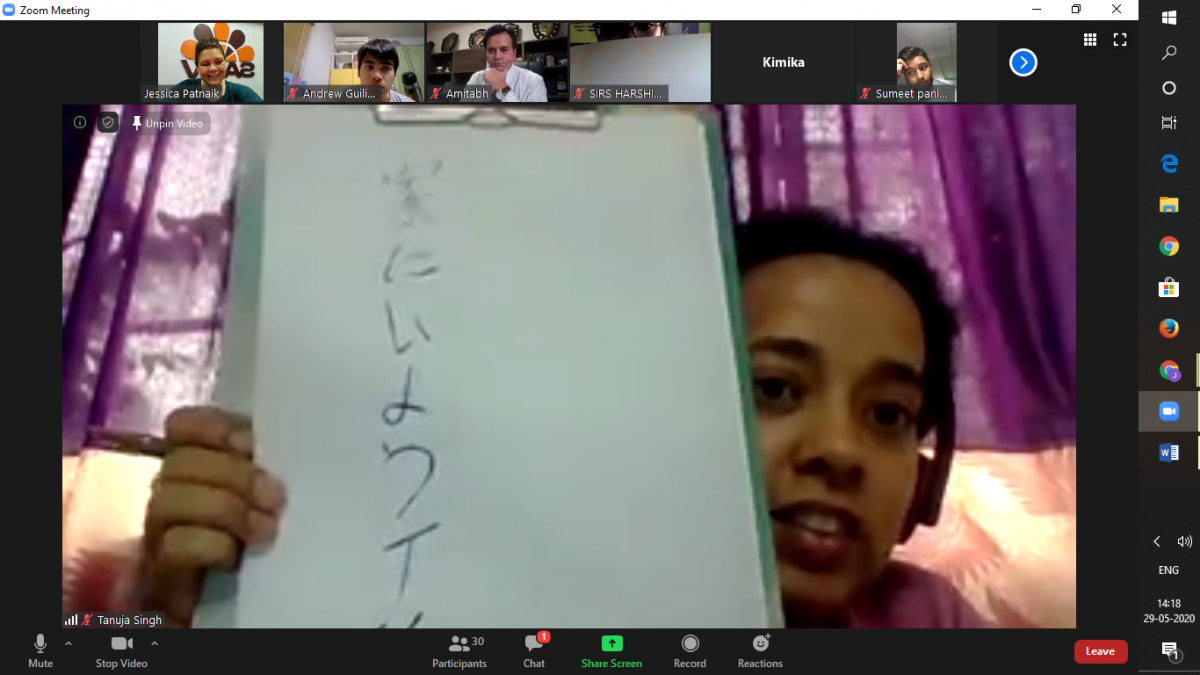“Your Turn” – comparing cultural differences in virtual collaboration
Posted: 17 August 2020

Schools involved:
- SAI International School
- Junior and Senior High School of Kogakuin University
Curriculum area:
Social studies
Age range:
Secondary
IDEALS:
- Internationalism
Discoveries
- Communication skills
- Inquisitiveness
- Appreciation for diversity
- Self-awareness
- Teamwork
Overview
Students from SAI International School in India and Junior and Senior High School of Kogakuin University in Japan have been meeting regularly during the lock-down via Zoom to explore cultural differences and to deepen their global understanding.
Whilst the global pandemic of COVID 19 has put a momentary stop to physical international travel, scuppering many schools plans to attend conferences, exchanges and service projects. SAI and Kogakuin have been utilising the power of technology to keep the Spirit of Internationalism alive within their schools.
Planning
SAI International School’s Round Square Rep, Jessica Patnaik initiated this collaboration by reaching out to Chiho Nakagawa, Round Square Rep of Junior and Senior High School of Kogakuin University. We had originally met at the 2019 Round Square International Conference in Indore and became firm friends, continuing to email each other over the last 6 months after the conference. We were working on organising student exchange groups to visit each other’s schools but unfortunately this plan was cancelled due to COVID-19 pandemic so we decided to collaborate virtually instead.
The aim of these virtual sessions is to promote international understanding through exposing our students to ideas and concepts from different cultures and countries, by challenging them to understand and tackle real-world issues, and by connecting them with other students from all nationalities.
The video conference calls take place every Friday at 1:00pm (IST) via Zoom. The schools take it in turns picking a theme for the discussion topic and then spend a few days prior to the call preparing for the meeting.
The meetings are very much student lead. Students vote on the next theme they are interested in learning about and create their own presentations. Even topic themed questions are written by the students themselves as they know which probing questions will spark the best conversations. Our role as teachers is just to supervise the call, keep track of time and if there is a lull in the activities to help get things back on track.
Details
Each week’s session starts out with an update on the COVID 19 situation in their respective countries. This has been a great way for students to understand how this pandemic has affected people across the globe and instantly gave them all something in common.
Each week students set a theme to focus their conversations around and take it in turns selecting the theme.
Students have presented on foods in their respective countries, with Kogakuin choosing Miso soup – a traditional Japanese soup consisting of a dashi stock into which softened miso paste is mixed, and SAI choosing Butter Chicken Marsala, and Indian dish of chicken in a mildly spiced tomato sauce. For this call, the students made videos on how to prepare the dishes which they then shared on the call. Recipes were shared via PowerPoint and then emailed to each other respective teacher so they could be shared with all the participants to try at home.
Students have also compared traditional dress from each country including Sarees and Kimonos with a special mention of a new trend happening in Japan where teenagers are wearing clothing designed after Anime characters. Students from both schools dressed in traditional clothes especially for the call with Kimika from Japan dressed in a traditional red and white checker Kimono and Orissa from India dressed in a traditional Rajathani Lehenga with mirror work.
Two weeks ago we covered famous artists from each country and learned how to write “Stay Safe Japan” and “Stay Safe India” in both Hindi and Japanese letters. Other topics have included sports and cultural festivities.
Last week our theme was “A Place for Peace”. We played a virtual game called “Pick your Peace” where students randomly picked numbered boxes that detailed different conflict situations ranging from nuclear war to a fight with a friend. Then on the spot they had to explain how that situation could be defused in a peaceful manner.
The next activity was to sharing posters and slogans that had been created by the students prior to the meeting. The Theme of Peace Poster/ Slogan was – Peace is a concept of societal friendship and harmony in the absence of hostility and violence. The students present both hand drawn posters and digital posters. Posters were shared about anything from Hiroshima and the effects that Nuclear War had on Japan, to the fight for freedom happening in Hong Kong and drawn posters included doves and handshakes and flags representing international peace.
The final exercise was really interesting. All the students wrote Peace Messages and posted them in the Zoom Meeting chat box. With a quick flash of peace signs and words of “goodbye” and “see you next week” the session ended.
Virtual classes took a twist when students had an open panel discussion on teenage freedoms. Questions ranged from “do you parents knock before they enter your room?” to “at what age did you get your first mobile phone?”. This was an excellent session that allowed the participants from both countries to really get to know one another.
Challenges
The biggest problem we faced at first was agreeing on a dedicated time and day each week to meet which was difficult due to the time difference from India and Japan. It was hard to fit the session around the student’s hectic online classes. Also for the first few sessions the students were a bit shy to share but this gradually decreased as the activities planned for each session drifted away from just PPT presentations toward more interactive sessions were a questions are asked and the students allowed time to give their perspectives.
It opened up the door to good communication between all the participants and we all learned so much about each other in a very short amount of time. Now we have learned that each session can have presentations but also require time for the students to just talk to each other through open dialog or pre-determined questions that evoke conversation. These probing questions should be set in advance and be about the session theme, and as mentioned earlier written by the students hosting that week. This means the teachers have to put a lot of thought on how they can extract as much participation and open conversations from all the participating students. The teacher hosting the session must be vigilant and able to read the virtual classroom creating as many learning possibilities as they can. Constantly keeping the momentum of the session going and keeping things on track time wises. We have found that an agenda should be presented to the students at the beginning of the class or even before the session so students know what they should expect and come mentally prepared.
Impact
This opportunity has offered our students the space to connect with those from different countries and cultures, exchanging points of view and ideas across borders and developing international and intercultural understanding.
The amount of shared learning taking place cannot be measured. Students are forming friendships and learning each other’s names. After the first few meetings a close bond has formed as students start to feel more comfortable speaking with each other.
Partnerships between schools in different countries offer a foundation for the growth of a school’s syllabus and subject areas incorporating a wider global input and international perceptions. During the meetings participating students foster international dialogues, collaborative virtual classes truly develop a common understanding between the youth of today.
Long term
We have already contacted another Round Square School: Shirakatsy Lyceum International Scientific-Educational Complex in Armenia to try this format of collaboration with them and have already had two “Your Turn” virtual sessions. In the first we focused just on the topic of COVID 19 and its effects on education. The Armenian Ambassador to India joined us, His Excellency Armen Martirosyan. We then made a collaborative short video called “All in the Name” in which students of both countries wrote their names along with slogans on how to beat COVID 19. This project has been published in the in our local news.
Advice
If your school is interested in starting your own weekly virtual classes then just start reaching out to your fellow Round Square schools globally. Start talking to other Round Square Reps about what types of online collaborations are possible and have an open mind, don’t be ridged, try different ways to make your schedules match. Try to keep your collaborations with schools within a 5-6 hour time difference so virtual classes are feasible for both your students and theirs. If they don’t like ZOOM pick another online platform you can agree on. COVID 19 has presented a perfect opportunity for online learning in a way never imagined before. International collaborative classrooms are literally just a click away.
Also post your collaborative activates on the Round Square website there is a specific area design just to coordinate and inviting all global RS Schools to participate. Also promote the project or activity within your region as well you automatically have direct contact with all the RS Schools in your region take advantage of that with the help of your regions School Support Director. Mine has been key in helping me build my rapport with other Round Square Schools and Reps.
Lastly don’t give up, just keep trying to make it happen. If I can do it so can you. Round Square offers so many resources and people to help your school became an active RS Member. Use the tools that are already there, take advantage of every meeting you have with fellow RS Reps and RS Schools. Take the lead just don’t wait around for someone to contact you. The benefits your school gets from its RS membership is entirely up to you. As a rep you can be a back benches or sit in the front seat and take the wheel.
Author: Jessica Patnaik, Round Square Rep, SAI International School
